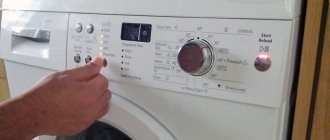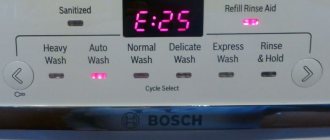Causes of the problem
It happens that even at the first start the machine refuses to perform its functions. It is unlikely that the new machine could break; most likely it was due to an incorrect connection. If the device is not connected in the established order, the machine constantly draws and drains water.
When connecting a drain hose normally, a competent installer makes two smooth bends in the hose: one directly at the entrance to the device, the other at the junction with the siphon. Without this, water from the drain may flow back into the car. Therefore, if normal draining is impossible, there will be no water circulation in the dishwasher. Accordingly, the water temperature will differ from the parameter set by the program, that is, the water will be cold, and the consumer will blame the heating element for everything.
In this case, there is no need to do it yourself; it is better to contact an installation specialist.
But if the connection to the cold water system is done correctly, and the dishwasher still does not heat the water, you need to approach troubleshooting more thoughtfully, or rather, analyze the interaction of all the components of the device that affect the heating of the water. Of the fundamental reasons, three main ones can be distinguished:
- failure of the heating element;
- The thermostat does not regulate the temperature;
- control system is faulty.
Checking and replacing the heating element
New dishwashers are required to be equipped with self-diagnosis systems. But in cases where problems arise with water heating, diagnostics often do not show error codes.
It is necessary to turn the machine over and, by removing the back wall, gain access directly to the heating element. The heating element is checked visually and using a tester and, if it is faulty, it is necessary to prepare for replacement. Due to the hardness of tap water, calcified scale deposits very heavily on the heating element, which sharply reduces the performance of this element. Therefore, heating element is considered a consumable material.
Electrolux dishwasher heating element
Replacing a heating element is a very expensive operation. The fact is that if a device such as a Bosch dishwasher does not heat water, then the heating element must be replaced as a whole module, which causes considerable financial costs.
Dismantling and replacing the heater
To replace it, you need to completely dismantle the assembly. For this:
- disconnect all contacts and chips;
- tighten the metal clamps;
- pull off the pipes;
- squeeze the rubber fasteners out of the body.
Clamps and rubber fasteners
Please note that not all models of Electrolux dishwashers are supplied with separate heaters. In this case, the supplier had a heating element. But in another option, you will have to purchase the entire assembly, despite the fact that the recirculation pump is working. This policy, in particular, is preached by.
Expert opinion
I work in the household appliance repair industry. Extensive experience in restoring washing machines and dishwashers.
Ask a Question
To disconnect the heater, you will need to show some dexterity, since you need to bend three plastic tabs and twist it at the same time. An assistant will not hurt, but this can be done by one person.
Removed unit
We carry out assembly in reverse order. You need to pay attention to the connections of the pipes. For reliability, before installing the side panels, it is better to connect the dishwasher to water and electricity and run a test wash.
Important! Make sure that there are no leaks anywhere, and only after that collect the PMM!
Don't forget to take out the rag. Otherwise it will interfere with washing. In addition, check the water heating. On a long cycle, it turns on after about 10 minutes. Immediately at the express car wash.
Machine assembly
Diagnostics and repair of the thermostat and control unit
The temperature sensor or thermostat is one of the weak points of most dishwashers. It is necessary to clearly understand that it is he who has failed, so the diagnostic algorithm will be as follows:
- We disconnect the device from the supply voltage and water supply;
- remove all dish baskets;
- dismantle the lower sprinkler and remove the garbage filter;
- install the device upside down and remove the side fastenings;
- carefully disconnect the drain pipe and lift the bottom of the dishwasher
- Having gained access to the thermostat, disconnect it from the supply wires;
- We clean the contacts of the temperature sensor and check it with a tester.
- if the thermostat is faulty, replace it and reassemble the dishwasher, having first checked the wiring leading to the thermostat.
Gorenje dishwasher temperature sensor
It happens that the temperature sensor is in order, and all other elements are checked, but the water is still cold. In this state of affairs, most likely the control unit, or one of its constituent elements, has failed. In this case, the dishwasher “computer” does not work, which compares all the data from other components of the device and gives a command to heat the water. If a malfunction occurs, the command to the heating element to heat the water may not go through.
The unit is very expensive, so only an experienced specialist should repair or replace it.
In addition to the main reasons for refusing to heat water, there are additional ones. It seems that they have nothing to do with heating the water, but this is not the case. Let us carefully analyze the following reasons:
- clogged dishwasher filter;
- the washing mode is incorrectly selected;
- failure of the pressure sensor.
Reasons for the lack of heating of water in the dishwasher
Most often, the dishwasher does not heat the water for the following reasons:
- heating element has failed;
- temperature sensor is faulty;
- control board failure.
The problem may not only be related to the heating system. Sometimes the cause of the malfunction may not have anything to do with heating the water, for example:
- the device is not connected correctly;
- the wrong dishwashing mode is used;
- the garbage filter is clogged;
- The pressure sensor is faulty. There is no need to rush to replace this element. Often, the breakdown can be eliminated by cleaning the contacts and checking the electrical wiring in the sensor circuit.
It would seem that the filter is not involved in the operation of the water heating system. However, due to its clogging, the circulation of water in the system is disrupted. The dishwasher draws water, but it does not flow back into the reservoirs from the tank. Ten can't cope with heat. To diagnose, you just need to look into the tank while the device is operating. If the filter is functioning properly, water should not stagnate in the hopper. Otherwise, cleaning must be done.
If the dishwasher is not connected to the drainage system correctly, the water circulation will also be disrupted. It will either not heat up at all, or the temperature will be too low. In such a situation, it is necessary to correctly connect the device to the drainage system, following the manufacturer’s instructions.
Clearing a clogged filter
The garbage filter is rightfully considered one of the main components of a dishwasher. Its functional task is to prevent food debris and dirt waste from penetrating the main working elements. Dirt gradually collecting in the filter cavity prevents normal water circulation in the device, so the heating element turns off and the dishwasher does not heat the water. To normalize the operation of the machine, it is necessary to clean the filter.
The bottom line is that when you turn on the washing program, water should communicate well between the storage tank and special containers. At this time, the heating element maintains a constant temperature necessary for high-quality washing. If the filter is partially or completely clogged with debris, circulation becomes far from normal. Water accumulates in the tank, and the system will be forced to replenish reserves using cold tap water. Ten won't be able to heat it up.
It is important for the consumer to remember that in order to avoid this malfunction, it is necessary to thoroughly clean the dishes before placing them in the dishwasher.
It would also be a good idea to look into the storage tank while working. If it fills with water, it is necessary to promptly clean the filter. As a result, normal circulation will be restored and the problem with water heating will disappear, unless the heating element fails due to a blockage or the thermistor does not burn out synchronously.
What can affect the operation of the heater?
May affect the operation of the heater in the dishwasher. Scale on the heating element. As soon as the heater becomes covered with scale. Overheating occurs. And it may fail.
Water getting into any element of the heating circuit. If there is a leak in the car. Water getting on sensors and wiring. It can negatively affect both the heating system and the entire operation as a whole.
Untimely cleaning of filters can affect both the water level sensor. Same goes for the pressure sensor. Residual deposits enter the system and can damage the sensors. Or distort their testimony
Life time. Not an unimportant factor. For some devices, the service life of the elements may simply be limited.
Selecting dishwasher modes
Very often, the water in the dishwasher does not heat up due to an incorrectly set mode. If the electromechanical regulator is fixed at 40 degrees, and the toggle switch is set at 90, then the device heats cold water to no more than 40 degrees.
The most advanced models always have a mode called “delicate wash”. When operating in this mode, the water also does not heat above 40 degrees. To avoid such troubles, you must carefully study the technical description of the device.
How can you tell if your dishwasher is not heating water?
Or your dishwasher showed an error on the display that it is not heating. Or something alarmed you about her work. And you understand. That most likely there is some kind of defect. Since the dishes were very poorly washed and covered in drops. For different dishwashers. The washing logic for a faulty heating element may vary.
Error in the dishwasher if there is no water heating
- Bosch/Siemens/Neff error E09
- Electrolux/AEG/Zanussi error i60
- Ariston error AL10
- Samsung error E3
- Beko error H2
- SMEG error E3
- ASKO error F1
Some models may stop after 15 minutes and indicate that there is a malfunction. Others, on the contrary, will wash as if nothing had happened. Some dishwashers. With a faulty water heating circuit. Washing time increases significantly. To understand whether heating occurs or not. It is enough to run a short wash cycle (not rinsing) and periodically open the door and test the water.
Features of the pressure sensor
The main purpose of this unit is to control the circulation of water in the machine. If the pressure sensor stops functioning, then continuous circulation of water occurs in the system, which ultimately leads to its automatic drainage. Naturally, the heating element with constant circulation simply does not have time to properly heat the water, and washing is done with cold water. The problem can be resolved by replacing the sensor, although you can try to clean its contacts and check the supply wiring.
As a result, it should be noted that if the water heating has disappeared, there is no need to be alarmed, but by consistently eliminating failure options, identify and eliminate the true cause of the failure.











